Related Research Articles
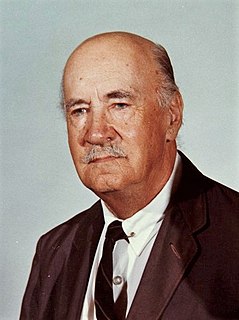
Igor Ivanovich Sikorsky was a Russian–American aviation pioneer in both helicopters and fixed-wing aircraft. His first success came with the S-2, the second aircraft of his design and construction. His fifth airplane, the S-5, won him national recognition as well as F.A.I. license number 64. His S-6-A received the highest award at the 1912 Moscow Aviation Exhibition, and in the fall of that year the aircraft won first prize for its young designer, builder and pilot in the military competition at Saint Petersburg.

Sikorsky Aircraft is an American aircraft manufacturer based in Stratford, Connecticut. It was established by Russian–American aviator Igor Sikorsky in 1923 and was among the first companies to manufacture helicopters for civilian and military use.

The Sikorsky S-29-A was a twin-engine sesquiplane airliner, first flown in 1924. It was the first aircraft that aviation pioneer Igor Sikorsky designed and built after coming to the United States, hence the special "-A" suffix signifying "America". The aircraft made many successful long range flights, most of which Sikorsky piloted himself. The S-29-A claims a number of "firsts" in aviation including the first twin engine aircraft capable of maintaining altitude on one engine, the first aircraft to broadcast a radio musical program in-flight, in 1925 and in 1926 the first aircraft to display a motion picture in flight. The S-29-A was also one of the first aircraft to make use of an airstair door, located on the starboard side of the fuselage.
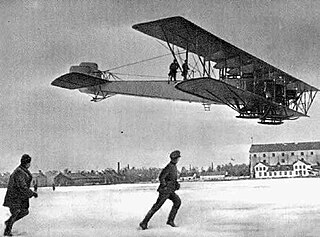
The Sikorsky Ilya Muromets were a class of Russian pre-World War I large four-engine commercial airliners and military heavy bombers used during World War I by the Russian Empire. The aircraft series was named after Ilya Muromets, a hero from Slavic mythology. The series was based on the Russky Vityaz or Le Grand, the world's first four-engined aircraft, designed by Igor Sikorsky. The Ilya Muromets aircraft as it appeared in 1913 was a revolutionary design, intended for commercial service with its spacious fuselage incorporating a passenger saloon and washroom on board. The Ilya Muromets is the world's first multi-engine aircraft in production and at least sixty were built. During World War I, it became the first four-engine bomber to equip a dedicated strategic bombing unit. This heavy bomber was unrivaled in the early stages of the war, as the Central Powers had no aircraft capable enough to rival it until much later.
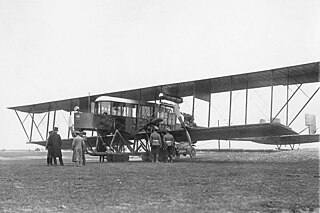
The Sikorsky Russky Vityaz, or Russian Knight (S-21), previously known as the Bolshoi Baltisky(The Great Baltic) in its first four-engined version, was the first four-engine aircraft in the world, designed by Igor Sikorsky and built at the Russian Baltic Railroad Car Works in Saint Petersburg in early 1913.
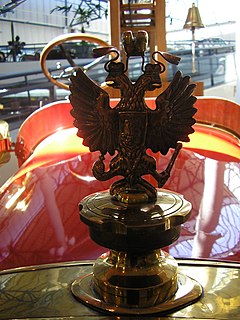
Russo-Balt was one of the first Russian companies that produced vehicles and aircraft between 1909 and 1923.

The Sikorsky VS-44 was a large four-engined flying boat built in the United States in the early 1940s by Sikorsky Aircraft. Based on the XPBS-1 patrol bomber, the VS-44 was designed primarily for the transatlantic passenger market, with a capacity of 40+ passengers. Three units were produced: Excalibur, Excambian, and Exeter, plus two XPBS-1 prototypes.

Sikorsky Glacier is a glacier on the west coast of Graham Land, Antarctica draining northwestwards into Hughes Bay north of Charles Point.

The Sikorsky S-16, or RBVZ S-XVI, was a Russian equi-span single-bay two-seat biplane designed by Igor Sikorsky in 1914-15. Conceived in response to demand for an escort fighter for the Ilya Muromets bombers, it was noteworthy in that it was one of the first aircraft to possess synchronisation gear for its 7.7 mm machine gun. The first S-XVI was completed on 6 February 1915 with an 80 hp engine instead of the intended 100 hp because of supply problems. On 17 December 1915, the Russian government placed an order for 18 aircraft, these being delivered in early 1916.

The Sikorsky S-20 or RBVZ S-XX was a Russian single-bay unequal span two-seat biplane designed by Igor Sikorsky in 1916. Displaying some Nieuport influence, it saw very little service during World War I.

The Sikorsky S-10 was a Russian military twin-float seaplane that served with the Russian Navy's Baltic Fleet from the summer of 1913 to 1915. After Igor Sikorsky built the successful Sikorsky S-6 for the Russian military, he tried to build another successful aircraft for them. The S-10 was a modified S-6B built by the Russo-Baltic Carriage Factory. Approximately sixteen production versions of the S-10 were built. It had a less powerful engine and generally weaker structure than the S-6. They had either an 80 hp Gnome Monosoupape or a 100 hp Argus Motoren engine. Some were deployed on the world's first operational seaplane carriers.

The Sikorsky S-5 was an early Russian single seat biplane design by Igor Sikorsky, completed in late April 1911.

The Sikorsky S-8Malyutka (baby) was a small Russian single engine aircraft built by the Russian Baltic Railroad Car Works shortly after Igor Sikorsky became chief engineer of the aircraft manufacturing division in 1912.
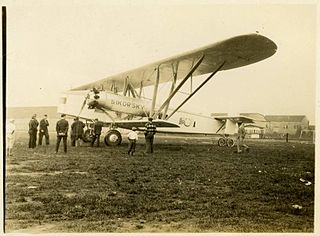
The Sikorsky S-37 was an American twin-engine aircraft built by the Sikorsky Manufacturing Corporation. Both examples of the series were completed in 1927. The S-37 was specifically designed to compete for the Orteig Prize and would be the last land based fixed-wing aircraft Sikorsky would produce.

The Sikorsky S-7 was a Russian single engine experimental prototype aircraft built by the Russian Baltic Railroad Car Works shortly after Igor Sikorsky became chief engineer of the aircraft manufacturing division.

The Sikorsky S-19 was a Russian twin engine experimental prototype biplane aircraft built late in 1916 by the Russian Baltic Railroad Car Works while Igor Sikorsky was chief engineer of the aircraft manufacturing division.
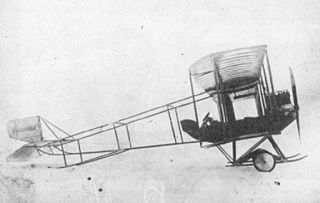
The Sikorsky S-6 was a Russian single engine experimental aircraft similar to the S-5, built in 1911 by Igor Sikorsky.

The Sikorsky S-11 Polukroogly was a Russian single engine prototype reconnaissance aircraft completed in July 1913 by the Russian Baltic Railroad Car Works while Igor Sikorsky was the chief engineer of the aircraft manufacturing division.

The Sikorsky S-12 was a Russian single engine trainer aircraft completed in the spring of 1913 by the Russian Baltic Railroad Car Works while Igor Sikorsky was the chief engineer of the aircraft manufacturing division.
The Sikorsky S-28 was a proposed four engine biplane bomber aircraft designed by Igor Sikorsky to be built in France during World War I. Sikorsky moved to France in March 1918 and soon met with officers of the Armée de l'Air who asked him to design an aircraft capable of carrying a new 1,000 kg (2,200 lb) bomb. Although the aircraft was initially designed to be powered by two Liberty L-12 engines, the technical section of the Armée de l'Air suggested using four Hispano-Suiza 8 engines instead.
References
- ↑ "The Russian Years". www.sikorskyarchives.com. Retrieved 27 April 2017.